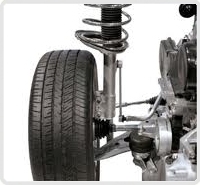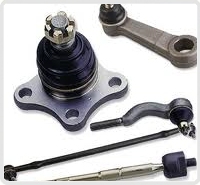|
Worn steering, suspension and drive line components
can cause noise, vibration, premature tyre wear and
misalignment. That's why we perform a complete
steering and suspension system inspection with every
alignment. By replacing worn parts you regain
steering control and handling which will return your
vehicle to its original operating performance.
If you are having steering or suspension problems or
if you hear unusual noises when driving over bumps
or dips in the road, see us for a comprehensive
steering and suspension inspection.
A Steering & Suspension Inspection includes;
- Road test
to determine steering & suspension performance
-
Inspection of steering and suspension system
- A report
and evaluation complete with our recommendations
- An
estimate for labor and parts requiring repair
or replacement
When to have this done
- When
noticing steering problems
- Noises
are heard when driving over bumps or clips in
the road
- When your
vehicles tyres show un-even wear
- If your
vehicle is pulling to the side while driving
Power Steering Fluid Check & Flush
Power steering fluid not only helps transfer
pressure from the steering wheel to the tyres, it
also lubricates the steering system. But like all
fluids in your vehicle, power steering fluid wears
out over time and must be replaced in order to
ensure proper vehicle control and the longevity of
steering components.
This service removes harmful contaminants and helps
prevent premature wear of steering components, and
maintains oil seal condition to help eliminate leaks
and ensure appropriate fluid viscosity for maximum
power steering performance. Your power steering fluid
should be checked with every engine oil change or
logbook service.
What's included
- Steering
system performance test
- Visual
inspection of the power steering components
- Flushing
the old fluid and refilling the system with new
fluid
CV Joint and Boot Service
Each vehicle has so called Constant Velocity (CV)
axle which consists of two Constant Velocity joints.
The main task of this CV axle is to transfer the
torque from the engine to the wheels of your
vehicle.
During its work the engine of your car produces a
lot of energy and the special mechanism is needed to
deliver all this torque to your car's wheels. And CV
joints allow all the power that engine gives to be
transferred very smoothly.
The most common problem that causes Constant
Velocity joints failure is crack in the boot. When
the boot is cracked it can no longer protect the
mechanism from the moisture and dirt. Dirt gets into
the unit which increases the wear of its parts. You
can even hear a noise (a clicking noise) during its
work. So when you hear that clicking sound in your
car's CV joints that can only mean the crack in the
boot.
|